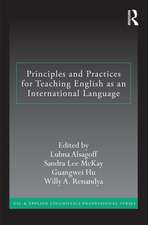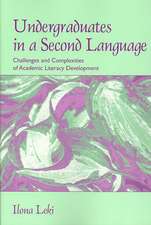Adult ESL/Literacy From the Community to the Community: A Guidebook for Participatory Literacy Training
Autor Elsa Auerbach, Byron Barahona, Julio Midy, Felipe Vaquerano, Ana Zambranoen Limba Engleză Paperback – 1996
Preț: 256.41 lei
Preț vechi: 342.05 lei
-25% Nou
Puncte Express: 385
Preț estimativ în valută:
49.06€ • 51.23$ • 40.61£
49.06€ • 51.23$ • 40.61£
Carte tipărită la comandă
Livrare economică 04-18 aprilie
Preluare comenzi: 021 569.72.76
Specificații
ISBN-13: 9780805822670
ISBN-10: 0805822674
Pagini: 240
Dimensiuni: 219 x 276 x 17 mm
Greutate: 0.59 kg
Ediția:1
Editura: Taylor & Francis
Colecția Routledge
Locul publicării:Oxford, United Kingdom
ISBN-10: 0805822674
Pagini: 240
Dimensiuni: 219 x 276 x 17 mm
Greutate: 0.59 kg
Ediția:1
Editura: Taylor & Francis
Colecția Routledge
Locul publicării:Oxford, United Kingdom
Public țintă
ProfessionalCuprins
Contents: Foreword. Acknowledgments. Preface: What Is This Guidebook? The Context and Rationale. Project Structure and Participants. The Training Component. From Training to Teaching. Evaluation. So What? Appendices: The Spanish Literacy Component, Byron Barahona. Promoting Native Language Literacy at the HMSC. Sample Training Workshops.
Recenzii
"The book is easy to read, and the authors add real-life examples and testimonials from mentors and interns to illustrate their points throughout. The authors effectively present their "from the community to the community" model as a viable approach for addressing ESL/literacy needs."
—The Ortesol Journal
"...the guidebook succeeds in clearly and powerfully explaining the underlying principles of the participatory approach to literacy teaching and community leadership development. The sample teacher training workshops and reflections included as an appendix were the crowning jewel of the guidebook. I urge all teachers, program administrators, students, funders, and policy makers who are interested in discovering new ways to improve the infrasturcture of our field to read this book."
—Bright Ideas
"The book is very collaborative, most of the chapters incorporating the views and voices of participants at all levels; it is deliberately written in a colloquial style and presnted in a reader friendly format. This makes it accessible to teachers, administrators, and higher-education faculty and students alike.
—The Modern Language Journal
"...a complexly layered documentation and analysis of critical praxis in the field....By skillfully and deeply weaving together theoretical foundations and daily practices, intentions and realizations, successes and struggles, [this book] captures both realistically and dramatically the rich texture of grass roots change as it is informed by the knowledge and experience of diverse participants and stakeholders....It will be useful to literacy practitioners, teacher educators, university faculty and graduate students, researchers in and out of the university, community-based educators, and others."
—Susan L. Lytle
University of Pennsylvania
"...explains the theoretical rationale [for] using students' first language as a resource for attaining literacy and ESL acquisition and also provides a step-by-step method for training teachers, usually former ESL students themselves, in this process...I especially appreciate the respect shown...for the mentors, teachers, and students in the program. The book makes clear how participatory and student-centered classes can and should operate. It shows the challenges, failures, and the many successes of the three sites described...Featuring the voices of the participants brings an immediacy and honesty to the text."
—Trudy Smoke
Hunter College, City University of New York
"...presents an implicit critique of much of the current practice of ESL and literacy instruction...[and] demonstrates innovative ways that underfunded literacy and ESL programs may expand and improve their offerings while strengthening ties to the communities of their students....ESL and literacy instructors and administrators who are interested in the participatory approach will find [this book] to be a practical handbook for program design. Its innovative approach to training interns has application for teacher training generally. Its detailed descriptions of alternative systems of program evaluation offer concrete ideas that can be adopted by ESL and literacy programs anywhere. Both administrators and teachers seeking a model for training and instruction will use it as a practical guide for their own work."
—James Tollefson
University of Washington
—The Ortesol Journal
"...the guidebook succeeds in clearly and powerfully explaining the underlying principles of the participatory approach to literacy teaching and community leadership development. The sample teacher training workshops and reflections included as an appendix were the crowning jewel of the guidebook. I urge all teachers, program administrators, students, funders, and policy makers who are interested in discovering new ways to improve the infrasturcture of our field to read this book."
—Bright Ideas
"The book is very collaborative, most of the chapters incorporating the views and voices of participants at all levels; it is deliberately written in a colloquial style and presnted in a reader friendly format. This makes it accessible to teachers, administrators, and higher-education faculty and students alike.
—The Modern Language Journal
"...a complexly layered documentation and analysis of critical praxis in the field....By skillfully and deeply weaving together theoretical foundations and daily practices, intentions and realizations, successes and struggles, [this book] captures both realistically and dramatically the rich texture of grass roots change as it is informed by the knowledge and experience of diverse participants and stakeholders....It will be useful to literacy practitioners, teacher educators, university faculty and graduate students, researchers in and out of the university, community-based educators, and others."
—Susan L. Lytle
University of Pennsylvania
"...explains the theoretical rationale [for] using students' first language as a resource for attaining literacy and ESL acquisition and also provides a step-by-step method for training teachers, usually former ESL students themselves, in this process...I especially appreciate the respect shown...for the mentors, teachers, and students in the program. The book makes clear how participatory and student-centered classes can and should operate. It shows the challenges, failures, and the many successes of the three sites described...Featuring the voices of the participants brings an immediacy and honesty to the text."
—Trudy Smoke
Hunter College, City University of New York
"...presents an implicit critique of much of the current practice of ESL and literacy instruction...[and] demonstrates innovative ways that underfunded literacy and ESL programs may expand and improve their offerings while strengthening ties to the communities of their students....ESL and literacy instructors and administrators who are interested in the participatory approach will find [this book] to be a practical handbook for program design. Its innovative approach to training interns has application for teacher training generally. Its detailed descriptions of alternative systems of program evaluation offer concrete ideas that can be adopted by ESL and literacy programs anywhere. Both administrators and teachers seeking a model for training and instruction will use it as a practical guide for their own work."
—James Tollefson
University of Washington
Notă biografică
Auerbach, Elsa; Barahona, Byron; Midy, Julio; Vaquerano, Felipe; Zambrano, Ana











